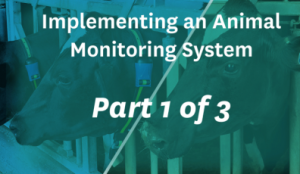Health and Welfare
Implementing a Monitoring System – Part 1 of 3

But reaching “Advanced User” status certainly doesn’t happen overnight. It’s an evolutionary process. It consists of three stages and the movement from one step to the next is very much dependent on the individual farm’s propensity to change.
The key priorities in the first stage of implementation are achieving efficiencies in reproduction and health management. The average farm typically masters this stage within a few months from the date of installation.
In practical terms, the primary goals of Stage 1 are: 1) maximize the number of cows bred to natural heats, and 2) redesign herd health program to be minimally disruptive for the cows and optimize treatment protocols.
The first two weeks after installation are critical to the success of this, and later stages of implementation. These first few weeks are all about building trust in the information the system generates.
During the first few weeks, there should not be any change from pre-system management protocols – the monitoring system is only used as an additional source of information. The idea is to begin building a connection between the reports and graphs to physical cow status. Understand that a cow appearing on a report needs to be bred or treated. If she doesn’t appear on the reports, we leave her alone. It’s that simple.
Once trust in the information is established, intervene ONLY with flagged cows.
Eliminating the unnecessary handling and treatments of healthy cows will create immediate savings on drugs and labor, leaving more time to work with cows that need intervention and reducing the disruption to the healthy cows’ daily routine.
With sick cows, examine the effectiveness of existing treatment protocols, both from a treatment choice perspective and from a treatment length perspective. Many farms find that their pre-system protocols are too aggressive and can begin experimenting with alternative treatment protocols, judging their effectiveness using the monitoring data.
On the reproduction side, breed to natural heats alongside the pre-existing TAI programs and/or other forms of heat detection.
Increased heat detection rate and improved insemination timing will complement the pre-system reproduction protocols and positively impact the number of pregnancies attained. Second service will be performed at 18-25 days following first service as open cows cycle (not after first pregnancy check) and reduce days open. Once the health monitoring and reduced stress start kicking in, one can expect conception rates to make an additional upward tick.
As soon as herd management gains confidence in the ability to control reproduction, they are ready to enter the second phase of implementation and rely solely on the monitoring system.













